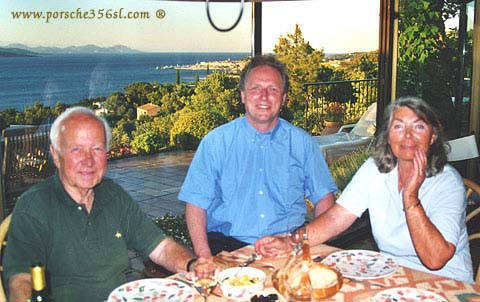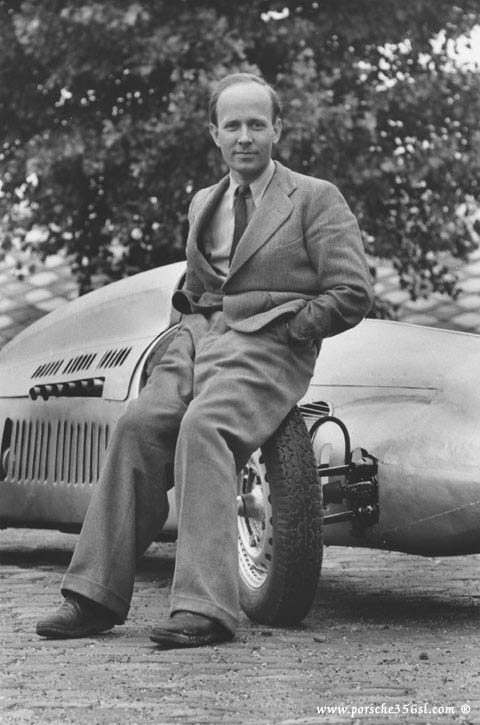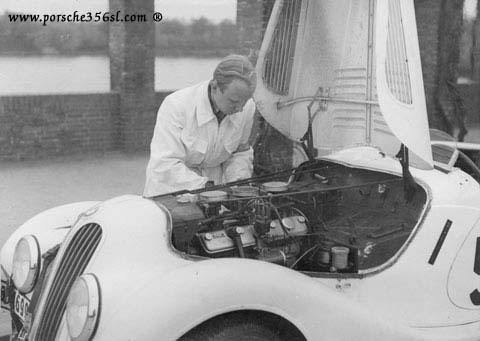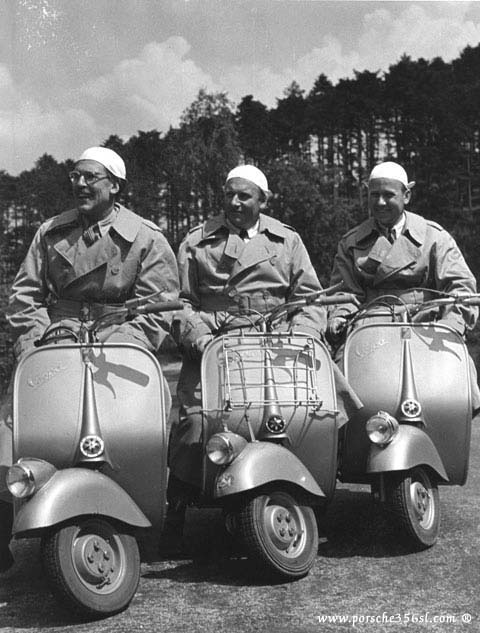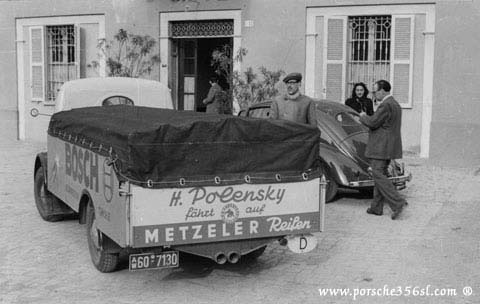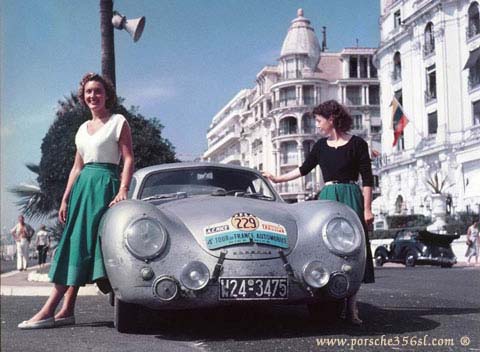|
Helmut & Ingeborg POLENSKY: King of the Mountain Helmut Polensky was born in Berlin on the 15th of October 1915. Although of Polish origin, his family had held German nationality for many generations. His father was a civil architect and Helmut was the youngest of four sons*. During the early years of his life in Berlin, he met his future wife, Ingeborg Marsson. She was born in Berlin on the 9th of May 1919 and was of Huguenot Ancestry. Helmut left school at the age of 18 and was called up for his military service in an artillery division during 1933. In the army he spent much of his time using a BMW motorcycle to obtain food supplies for his battery. Sadly, Helmut’s father died after a car accident in May 1936. Some months later Helmut visited Detroit, the center of the American car production, using part of his inheritance plus a subsidy from a German car club to finance the trip. At the time, many Europeans involved or interested in the car industry, visited the U.S. to uncover the reasons for the strength of American car production. Ferdinand Porsche and Pierre D’Ieteren were among those who also made the pilgrimage. The young Polensky had his first taste of motor sport in 1934 when he took part in the 2000 km of Germany race, using his motorcycle. Helmut’s first car was a second hand BMW 319 that he bought in 1937, later exchanging this for a BMW 328 Sport. Using this car he took part in his first car race, held in the stadtpark on the 7th May 1939 and finished in first place. After this success, he joined the N.S.K.K. (nationalsozialistische kraftfahrkorps), the only body able to issue competition licenses. The opportunity to work as a voluntary apprentice in the industrial and commercial Auto Union organization provided Helmut with the chance to meet Ferdinand Porsche, the designer of the Grand Prix cars, made by the organization. He soon became Huscke von Hanstein sporting rival, beating the “rennbaron” at the Grossglockner hill climb held in the Austrian Alps. This was called the “Grosser Bergpreis von Deutschland” for political reasons. At the awards ceremony held at Zell am See, Helmut was given the title of champion of Germany in the 2 -liter class along with his trophy. With this in his pocket he drove back home to Berlin, stopping every 50 km or so because filling stations were restricted to selling five liters of fuel at a time and no more. During this time, at his own request, Helmut was exempted from wearing a uniform. Sadly this was not to last and at the Grand Prix de Liège on the 26th August; he was called into the army and took part in the invasion of Poland on the 1st September. In the end the race was cancelled with the declaration of war. In December of 1939, he was sent to the school for ground force officers (Oberkommando Heeres or OKH). Helmut was assigned a post in the logistics centre in Berlin, which was to last for the duration of the war. In April 1945, with the Russians starting to enter Berlin, Helmut escaped and fled to Hamburg under the rain of allied bombs. After being taken prisoner of war in Hamburg, he was soon released and found rented accommodations in the city. As he saw very little active service during the war, he was considered to be a “good German” by the British occupational forces and made manager of a small company reboring cylinder blocks. Helmut married his sweetheart, Ingeborg, in February 1947. At the beginning of 1948 he left Hamburg to become a concessionaire for the Italian company Vespa, in Stuttgart. While there, Ingeborg met Professor Albert Prinzing**, her former Italian teacher who was working for the Porsche design bureau. The first Porsche cars were being built at that time at Gmünd in Austria. After a few years, Professor Prinzing introduced Helmut Polensky to Richard von Frankenberg, which resulted in a long friendship between the two men. Meanwhile, the young couple had a nasty shock when on the 20th of June 1948 the Reichsmark was devalued, and like every other German, they only received 40 new Deutsch Marks on which to survive. Just like the chronic inflation after the 1st world war, people lost all their savings. So the Polensky’s had to start again with almost nothing. Luckily Helmut inherited a building in Berlin although it was slightly damaged during the war. Thanks to his reputation gained in Hamburg with the small company and the occupying forces, Helmut managed to obtain a low interest loan to pay for the cost of repairs. This piece of good fortune together with some new projects signalled the start of a more prosperous life for the Polenskys. One of Polensky’s projects was to use the motor from his pre-war BMW 328 and a Volkswagen suspension to construct a Formula 2 car. This was a very fashionable thing to do in those years after the war. Enzo Ferrari and many others indulged in this practice before moving on to Formula 1. Helmut divided his energies between earning a living and his sporting interests. Another project was the construction of three single seat Formula 3 cars called “Monopoletta” using BMW motorcycle engines. At this time Helmut also changed his work to become an independent salesman at the VW dealers, garage Gramling in Karlsruhe. In 1952 Helmut bought a red 1500 Super from Ferry Porsche, whom he had met for the first time the year before. At the beginning of August 952, he used this car to take part in the Coupe des Alpes Rally. During this rally he had the good fortune to meet Max and Gilberte Thirion when they stopped to help Helmut, after his fuel pump failed. The “bon Porschistes Belge” happened to be carrying a spare pump “just in case”. Although Helmut led his class at one stage, he did not finish the rally. Helmut wanted to take part in the Liège Rome Liège rally towards the end of the same month. To give him a reasonable change of success, he asked his old friend Huschke von Hanstein to lend him an aluminium-bodied Gmünd SL. Unfortunately almost all of the rare works cars had already been allocated to other drivers. But one car had been sold to a customer in Belgium, Max Thirion. Helmut contacted the Thirion’s and persuaded them to lend him their car. In this car he won the “marathon de la route” which constituted the first “overall race win” for Porsche in competition. After this, Max Thirion was co-driver in Helmut’s 1500 Super, which they drove together in the 1953 Mille Miglia. The car was also driven with great panache by Gilberte Thirion in a race at the Nürburgring during the same year. Max Thirion was the Belgian importer for Champion spark plugs and in due course put Helmut Polensky in touch with the company in America. Champion appointed him importer for Germany, Switzerland, Austria and Hungry. As for Ingeborg, she became Gilberte Thirion’s co-driver in such rallies as the Tour de France and the Tour de Belgique for the next three years. Following von Hanstein’s refusal to lend Helmut a factory Gmünd, he drove a Fiat, a Lancia and his own Porsche in numerous international rallies during 1953. With his co-driver, Walter Schlütter, he won the Travemünde rally and the Alpine Rally becoming the first European rally champion. The next year, the Porsche factory employed Polensky to drive a Spyder 550 in long distance races such as Le Mans 24 hours, in which he retired, and the 12 heures de Reims with Richard von Frankenberg, where they achieved a class victory. Polensky also had a first in class victory in the Liège-Rome-Liège with co driver Herbert Linge. They were at the wheel of an old factory Gmünd, fitted with a four-cam Carrera engine. 1955, saw Helmut driving in his last competitions, at the Nürburgring, in Avus and with his friend Richard von Frankenberg at Le Mans. At the Le Mans race they achieved 4th place overall and won the index of performance. That same year in the Liège-Rome-Liège rally, he retired with mechanical problems. Finally Helmut Polensky retired from competition in order to devote more time to his business. His business was very successful and permitted him to retire in St.-Tropez on the Riviera, living peacefully with his wife. But every time he returned to France from visiting Germany, he took a detour to Stelvio and Gavia and relived the times when he was European rally champion. Notes * The first born, Gorg, died soon after birth. The other brothers were Hans Otto and Werner, born in 1905 and 1911 respectively. ** Albert Prinzing was an old school friend of Ferry Porsche in Cannstatt. During the 2nd world war he was one of the youngest professors in Germany, teaching economics at Berlin University. He was also counsellor to the Cultural attaché at the German Embassy in Rome and interpreted for Mussolini. He was imprisoned until 1948 when he returned to Stuttgart to become financial director of the Porsche Company.
&Ingeborg Polensky in 2000 with the author
In 1948, Helmut Polensky open a Vespa dealershop in the Stuttgart erea. He organized a rally
Helmut Polensky et Walter Schlütter at the Sicilia Gior 1950 on a beetle.
Tour de France Rally 1954, Ingeborg Polensky is co-driver of Gilberte Thirion on the |
|
Polensky
|
